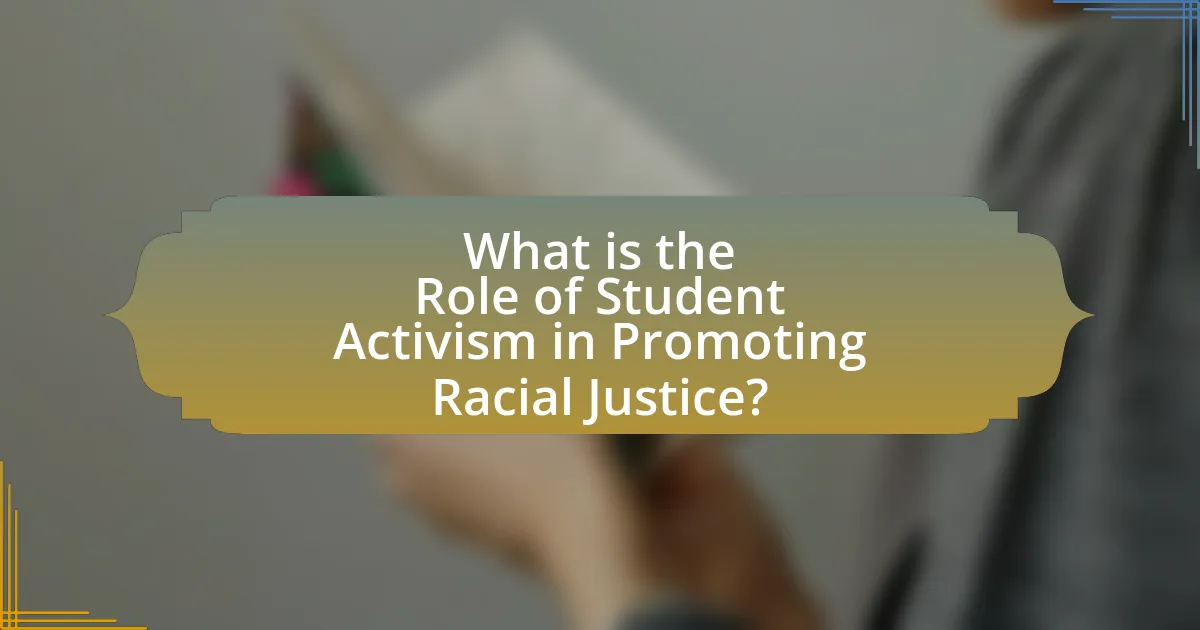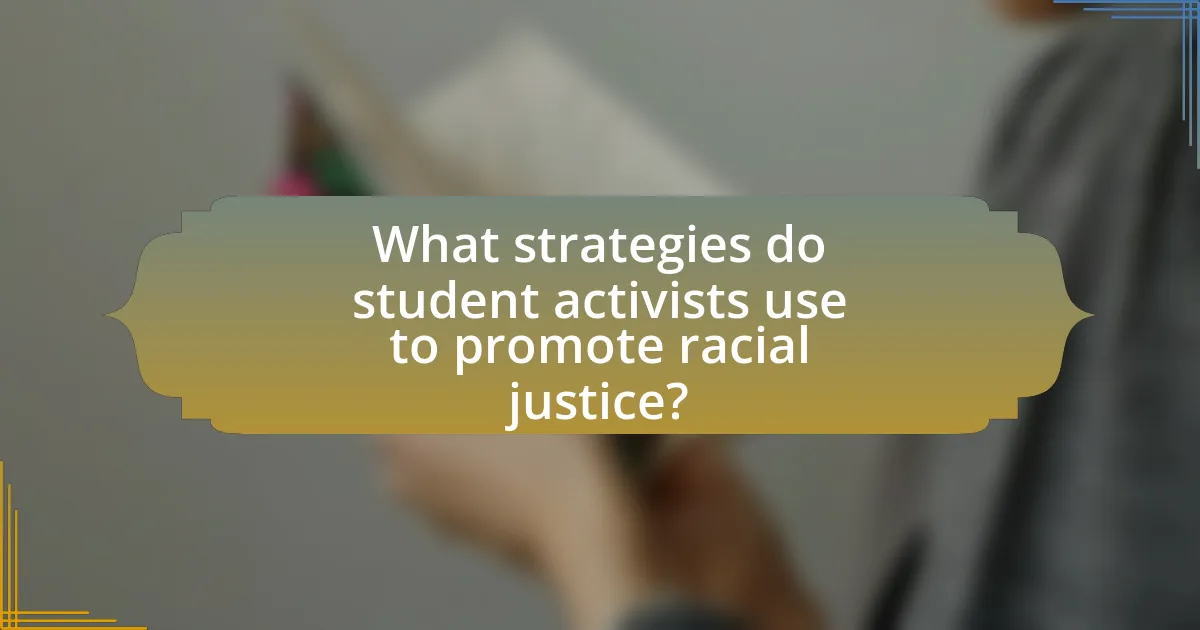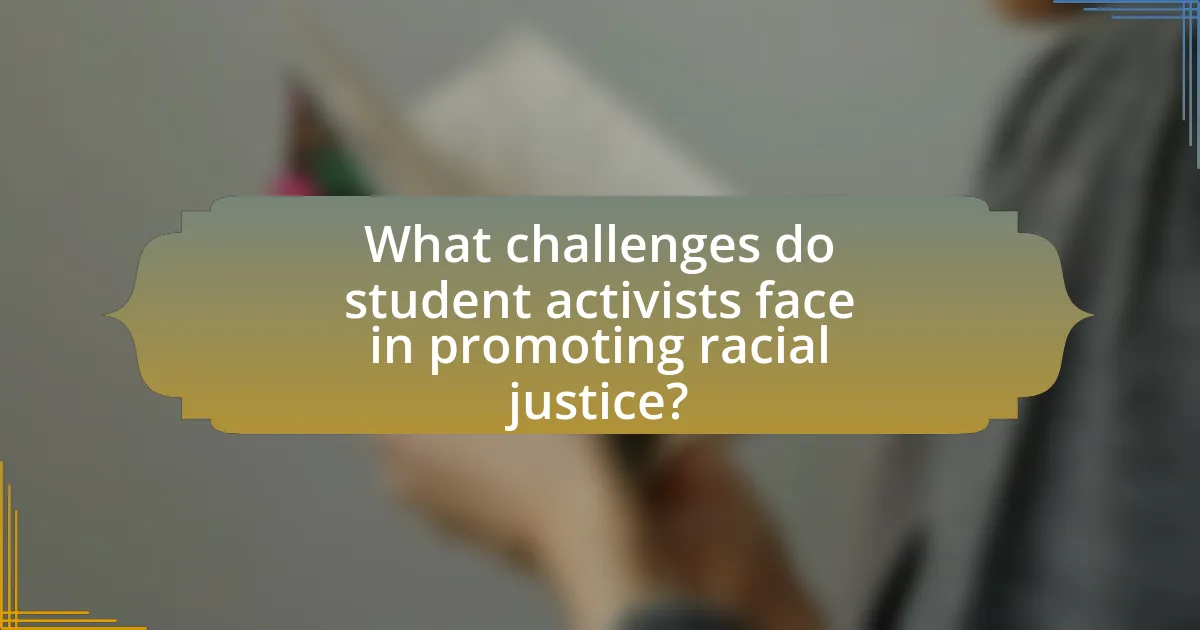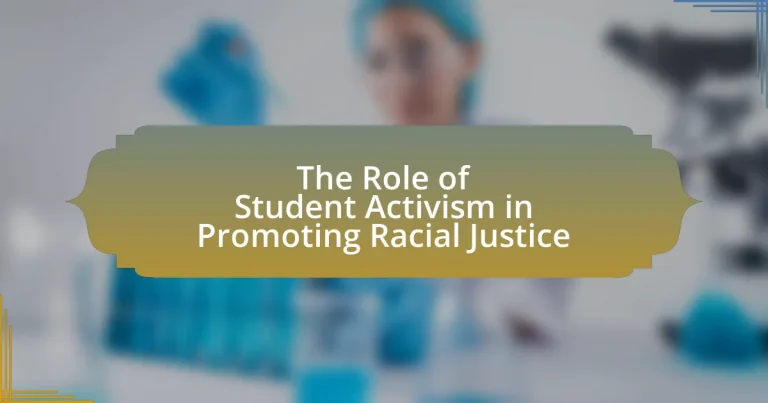The article examines the critical role of student activism in promoting racial justice, highlighting its historical significance and contemporary impact. It details how student-led movements, from the Civil Rights Movement to the Black Lives Matter initiative, have mobilized young people to advocate for systemic change and raise awareness about racial inequalities. Key events, strategies, and challenges faced by student activists are discussed, along with the influence of social media and intersectionality in shaping their efforts. The article emphasizes the importance of inclusivity and collaboration with community organizations to enhance the effectiveness of racial justice initiatives.

What is the Role of Student Activism in Promoting Racial Justice?
Student activism plays a crucial role in promoting racial justice by mobilizing young people to advocate for systemic change and raise awareness about racial inequalities. Historically, student-led movements, such as the Civil Rights Movement in the 1960s, have been instrumental in challenging discriminatory practices and policies, leading to significant legislative changes like the Civil Rights Act of 1964. Current examples include the Black Lives Matter movement, where students organize protests, engage in social media campaigns, and influence university policies to address racism on campuses. These actions not only amplify marginalized voices but also foster solidarity among diverse groups, creating a collective push for equity and justice.
How has student activism historically contributed to racial justice movements?
Student activism has historically played a crucial role in advancing racial justice movements by mobilizing young people to challenge systemic racism and advocate for civil rights. For instance, during the Civil Rights Movement of the 1960s, students organized sit-ins, protests, and voter registration drives, significantly contributing to the desegregation of public spaces and the passage of landmark legislation such as the Civil Rights Act of 1964. The Student Nonviolent Coordinating Committee (SNCC), formed in 1960, exemplified this activism by empowering students to take direct action against racial injustice, leading to increased national awareness and support for civil rights initiatives. Additionally, student-led movements in the late 20th century, such as those at universities advocating for divestment from apartheid South Africa, further demonstrated the impact of student activism in shaping public discourse and policy regarding racial equity.
What key events illustrate the impact of student activism on racial justice?
Key events that illustrate the impact of student activism on racial justice include the 1960 Greensboro sit-ins, where students from North Carolina A&T State University protested segregated lunch counters, leading to widespread desegregation efforts. Another significant event is the 2015 Black Lives Matter protests initiated by students at the University of Missouri, which resulted in the resignation of the university president and sparked national conversations about racial inequality on campuses. Additionally, the March for Our Lives movement in 2018, led by student survivors of the Parkland shooting, highlighted the intersection of gun violence and racial justice, advocating for policy changes that address systemic racism. These events demonstrate how student activism has historically catalyzed social change and influenced public policy regarding racial justice.
How have different generations of students engaged in activism for racial justice?
Different generations of students have engaged in activism for racial justice through organized protests, advocacy campaigns, and social media mobilization. For instance, during the Civil Rights Movement of the 1960s, students played a crucial role by participating in sit-ins, freedom rides, and marches, exemplified by the Student Nonviolent Coordinating Committee (SNCC) which was founded in 1960. In the 1990s, students focused on issues like affirmative action and police brutality, leading to significant demonstrations on college campuses. More recently, the Black Lives Matter movement has seen students utilize social media platforms to organize protests and raise awareness, with events like the 2020 George Floyd protests drawing thousands of student participants nationwide. This historical continuity illustrates how each generation adapts its methods to the prevailing social and technological context while maintaining a commitment to racial justice.
Why is student activism crucial for advancing racial justice today?
Student activism is crucial for advancing racial justice today because it mobilizes young people to challenge systemic inequalities and advocate for policy changes. Historically, student movements have played a significant role in civil rights advancements, such as the 1960s sit-ins and the formation of organizations like the Student Nonviolent Coordinating Committee, which directly contributed to the Civil Rights Act of 1964. Current student-led initiatives, such as the Black Lives Matter movement on campuses, highlight issues like police brutality and racial discrimination, fostering awareness and engagement among peers. This activism not only amplifies marginalized voices but also pressures institutions to implement reforms, demonstrating the effectiveness of collective action in driving societal change.
What unique perspectives do students bring to the racial justice conversation?
Students bring fresh, innovative perspectives to the racial justice conversation by integrating their lived experiences and diverse backgrounds into activism. Their unique viewpoints often stem from being part of marginalized communities, which allows them to highlight systemic inequalities and advocate for change in ways that resonate with their peers. For instance, student-led movements like Black Lives Matter at School emphasize the importance of inclusive curricula and equitable school policies, reflecting the urgent need for reform in educational institutions. This grassroots activism is supported by research indicating that youth engagement in social justice issues can lead to significant policy changes, as seen in various successful campaigns across the United States.
How does student activism influence policy changes related to racial justice?
Student activism significantly influences policy changes related to racial justice by mobilizing public opinion and pressuring decision-makers. Through organized protests, social media campaigns, and advocacy efforts, students raise awareness about racial injustices, compelling institutions and governments to address these issues. For instance, the Black Lives Matter movement, which gained momentum through student-led initiatives, has led to policy reforms in various cities, including the implementation of police accountability measures. Research from the Harvard Kennedy School indicates that youth-led movements can effectively shift legislative priorities, demonstrating the tangible impact of student activism on racial justice policies.

What strategies do student activists use to promote racial justice?
Student activists promote racial justice through strategies such as organizing protests, engaging in advocacy, and utilizing social media campaigns. Protests serve as a visible demonstration of solidarity and demand for change, often drawing attention to specific issues like police brutality or systemic racism. Advocacy efforts involve lobbying for policy changes at local, state, or national levels, where student activists work with lawmakers to influence legislation that addresses racial inequities. Social media campaigns amplify their messages, allowing for rapid dissemination of information and mobilization of supporters, as seen in movements like Black Lives Matter, which gained significant traction through platforms like Twitter and Instagram. These strategies collectively enhance awareness and drive action towards achieving racial justice.
How do social media platforms enhance student activism for racial justice?
Social media platforms enhance student activism for racial justice by providing a space for rapid information dissemination and community mobilization. These platforms enable students to share experiences, organize events, and amplify their voices on issues related to racial injustice. For instance, the hashtag #BlackLivesMatter gained global traction through social media, allowing students to connect with broader movements and engage in discussions that raise awareness about systemic racism. Additionally, studies show that social media campaigns can lead to increased participation in protests and advocacy efforts, as seen during the George Floyd protests in 2020, where student-led initiatives utilized platforms like Twitter and Instagram to coordinate actions and share resources.
What role does online organizing play in mobilizing student activists?
Online organizing plays a crucial role in mobilizing student activists by facilitating communication, coordination, and outreach among diverse groups. It enables students to quickly share information, organize events, and rally support for causes, particularly in the context of racial justice movements. For instance, platforms like Twitter and Instagram have been instrumental in amplifying messages and mobilizing protests, as seen during the Black Lives Matter movement, where social media campaigns led to significant student participation in demonstrations across universities. This digital engagement not only fosters a sense of community but also empowers students to take collective action, making online organizing an essential tool for effective activism.
How can social media campaigns effectively raise awareness about racial issues?
Social media campaigns can effectively raise awareness about racial issues by leveraging their vast reach and ability to engage diverse audiences. These campaigns utilize targeted messaging, visual storytelling, and interactive content to highlight racial injustices and mobilize support. For instance, the #BlackLivesMatter movement gained significant traction through social media, leading to increased public discourse and policy discussions surrounding systemic racism. Research indicates that social media platforms can amplify marginalized voices, with studies showing that 70% of users believe social media is a powerful tool for social change. By fostering community engagement and encouraging user-generated content, social media campaigns can create a collective impact that raises awareness and drives action on racial issues.
What types of events do student activists organize to promote racial justice?
Student activists organize various events to promote racial justice, including protests, educational workshops, and community forums. Protests serve as a powerful means of raising awareness and demonstrating solidarity against racial injustices, often drawing large crowds and media attention. Educational workshops focus on informing participants about systemic racism, historical context, and strategies for advocacy, thereby empowering individuals to take action. Community forums provide a platform for dialogue among students, faculty, and community members, fostering collaboration and collective action. These events are essential in mobilizing support and creating a more informed and engaged community regarding racial justice issues.
How do protests and demonstrations contribute to the racial justice movement?
Protests and demonstrations significantly contribute to the racial justice movement by raising awareness, mobilizing communities, and influencing policy changes. These collective actions serve as a platform for marginalized voices, highlighting systemic injustices and demanding accountability from institutions. For instance, the Black Lives Matter protests following the death of George Floyd in 2020 galvanized global attention, leading to discussions on police reform and racial equity. Research by the Pew Research Center indicates that public support for racial justice initiatives surged during these protests, demonstrating their effectiveness in shaping public opinion and policy discourse.
What educational initiatives are led by students to foster racial awareness?
Students lead various educational initiatives to foster racial awareness, including workshops, discussion panels, and awareness campaigns. For example, student organizations often host events that focus on the history and impact of systemic racism, encouraging peer-to-peer dialogue and reflection. Research indicates that such initiatives can significantly enhance understanding and empathy among participants, as evidenced by studies showing increased awareness of racial issues following student-led programs. Additionally, initiatives like the “Black Lives Matter at School” movement, which promotes curriculum changes to include more diverse perspectives, demonstrate the effectiveness of student activism in driving educational reform and fostering racial awareness.

What challenges do student activists face in promoting racial justice?
Student activists face significant challenges in promoting racial justice, including institutional resistance, lack of resources, and social backlash. Institutional resistance often manifests as administrative pushback against protests or initiatives, limiting the effectiveness of student-led movements. Additionally, many student activists struggle with inadequate funding and support, which hampers their ability to organize events or campaigns. Social backlash can include harassment or ostracism from peers and community members who oppose their views, creating a hostile environment that discourages activism. These challenges collectively hinder the progress of racial justice initiatives within educational institutions.
How do institutional barriers affect student activism for racial justice?
Institutional barriers significantly hinder student activism for racial justice by limiting access to resources, suppressing free speech, and creating an environment of fear and retaliation. These barriers manifest in policies that restrict protest activities, inadequate support for marginalized student groups, and a lack of institutional commitment to addressing racial inequalities. For instance, universities may impose strict regulations on demonstrations, which can discourage students from organizing events that advocate for racial justice. Additionally, when institutions fail to provide safe spaces for dialogue or ignore the concerns raised by activists, it undermines the effectiveness of their efforts. Research indicates that campuses with supportive policies and resources for activism see higher levels of student engagement in racial justice initiatives, highlighting the critical role that institutional support plays in fostering a vibrant activist culture.
What are the common obstacles students encounter when organizing for racial justice?
Students commonly encounter obstacles such as lack of institutional support, limited resources, and internal divisions when organizing for racial justice. Lack of institutional support often manifests in resistance from school administrations, which can hinder students’ ability to mobilize effectively. Limited resources, including funding and access to venues for events, restrict the scope and impact of their initiatives. Internal divisions among student groups can lead to conflicting priorities and weaken collective action, making it challenging to present a unified front. These obstacles collectively impede the effectiveness of student activism in promoting racial justice.
How can students overcome resistance from educational institutions?
Students can overcome resistance from educational institutions by organizing collective actions, such as protests and petitions, to advocate for their demands. Historical examples, such as the Civil Rights Movement, demonstrate that coordinated efforts can lead to significant policy changes within educational systems. For instance, student-led protests at universities in the 1960s successfully challenged discriminatory practices and prompted institutions to adopt more inclusive policies. By leveraging social media and building coalitions with faculty and community organizations, students can amplify their voices and create pressure for institutional change.
What role does intersectionality play in student activism for racial justice?
Intersectionality plays a crucial role in student activism for racial justice by highlighting how various social identities, such as race, gender, sexuality, and class, intersect to create unique experiences of oppression and privilege. This framework allows student activists to understand that racial justice cannot be achieved in isolation from other forms of discrimination; for example, Black women face different challenges than Black men due to the intersection of race and gender. Research by Kimberlé Crenshaw, who coined the term “intersectionality,” emphasizes that addressing these overlapping identities is essential for effective advocacy and policy change. By incorporating intersectionality, student activists can create more inclusive movements that address the needs of all marginalized groups, thereby strengthening their efforts for racial justice.
How do various identities influence student activism efforts?
Various identities significantly influence student activism efforts by shaping perspectives, priorities, and strategies. For instance, students from marginalized racial and ethnic backgrounds often prioritize issues related to racial justice, drawing from personal experiences of discrimination. Research indicates that identity-based groups, such as Black Student Unions or LGBTQ+ organizations, mobilize their members around specific social justice issues, enhancing collective action. A study by the American Council on Education found that diverse student identities lead to more inclusive activism, as students advocate for policies that address the unique challenges faced by their communities. This intersectionality fosters solidarity among different groups, amplifying the impact of activism efforts in promoting racial justice.
What strategies can be employed to ensure inclusivity in racial justice activism?
To ensure inclusivity in racial justice activism, organizations should implement strategies such as actively engaging diverse communities, fostering intersectional dialogue, and prioritizing representation in leadership roles. Engaging diverse communities involves outreach efforts that specifically target marginalized groups, ensuring their voices and experiences are integral to the activism process. Fostering intersectional dialogue means recognizing and addressing the interconnectedness of various forms of oppression, which can enhance solidarity among different racial and social groups. Prioritizing representation in leadership roles ensures that decision-making bodies reflect the diversity of the communities they serve, which can lead to more effective and inclusive strategies. Research indicates that inclusive movements are more successful in achieving their goals, as seen in the 2017 Women’s March, which highlighted the importance of intersectionality and diverse representation in mobilizing support for racial justice.
What practical steps can students take to enhance their activism for racial justice?
Students can enhance their activism for racial justice by organizing awareness campaigns and participating in community outreach programs. These initiatives can include hosting workshops, panel discussions, and educational events that focus on racial equity and social justice issues. Research shows that student-led movements, such as the Black Lives Matter movement, have significantly influenced public discourse and policy changes regarding racial justice. By collaborating with local organizations and leveraging social media platforms, students can amplify their message and reach a broader audience, thereby fostering a more inclusive dialogue around racial issues.
How can students effectively collaborate with community organizations for racial justice?
Students can effectively collaborate with community organizations for racial justice by engaging in mutual goal-setting, participating in community events, and leveraging their skills for advocacy. By aligning their objectives with those of established organizations, students can create impactful initiatives that address systemic issues. For instance, students can volunteer for local racial justice campaigns, which not only amplifies the organization’s efforts but also provides students with practical experience in activism. Research shows that collaborative efforts, such as those documented in the “Youth Activism and Community Engagement” study by the University of California, demonstrate that partnerships between students and organizations lead to increased community awareness and mobilization around racial justice issues.
What resources are available to support student-led racial justice initiatives?
Student-led racial justice initiatives can access various resources, including grants, mentorship programs, and educational materials. Organizations such as the NAACP and the Southern Poverty Law Center provide funding and support for projects aimed at promoting racial equity. Additionally, universities often have diversity offices that offer resources, workshops, and training sessions to empower student activists. Research indicates that funding from organizations like the Open Society Foundations has significantly bolstered grassroots movements, demonstrating the impact of financial support on the effectiveness of these initiatives.


